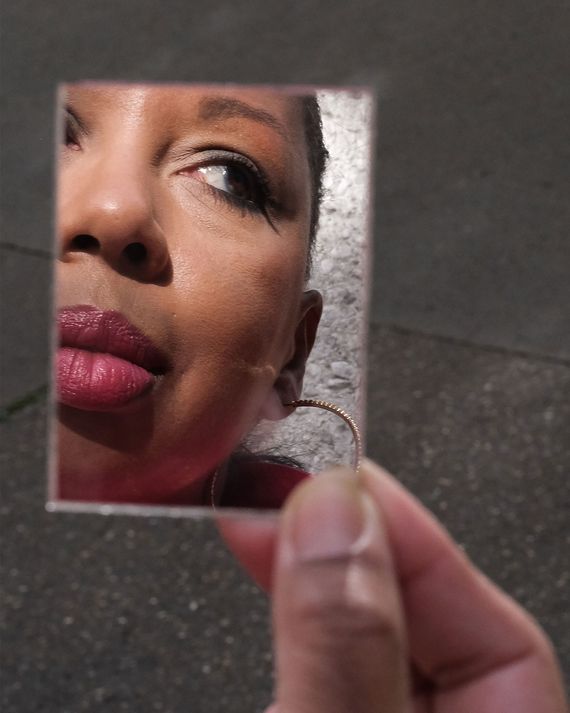
Marie NDiaye does not seek clarity. She is nearsighted, but you won’t find her in glasses. Born and raised in France, for years the writer lived in Berlin, where she enjoyed the fact that she did not speak perfect German — it produced, she told me in French, “a haziness that suited me.” In her novels, she plunges her characters, usually women, into a visceral experience of difference, often without naming what that difference is. Their worlds are inhospitable and uncanny, their families estranged or indifferent. While their internal landscapes overflow with guilt and shame that can feel racially coded, their traits are blurred, leaving readers with an interpretive gap to fill. Although her later novels allude more directly to color and class anxiety, her texts still inspire a paranoia about how to read her protagonists, catching us in a game of complicity. When I told the writer that it was often mysterious why the characters are so alienated, she was pleased. “Staying in an ambiguity, even in a form of discomfort — that suits me very well,” she said.
This week, NDiaye will publish her 12th novel, Vengeance Is Mine, in an English translation by her primary translator, Jordan Stump. At 56, she’s a former wunderkind; after publishing her first novel at 17, she has produced a body of work that includes plays, short stories, children’s books, and screenplays for Claire Denis’s 2009 White Material and for Alice Diop’s Saint Omer from last year. In France, she is among the country’s most famous living authors. While some readers find her work inscrutable, critics and academics delight in her hyperliterary texts, ripe for the picking apart. NDiaye herself avoids labels. When she became the first Black woman to win the Goncourt, France’s biggest prize in literature, in 2009, she said she had “never thought of it in those terms: ‘black woman’ and ‘Goncourt,’” before adding, “I don’t represent anything or anyone. I have met many French people raised in Africa who are more African than I am.”
Vengeance Is Mine begins with a troubling encounter. Maître Susane, a middle-aged lawyer, has just opened her own practice when she’s visited by Gilles, a man she believes she knows from her childhood — but who doesn’t seem to recognize her. He asks her to defend his wife, Marlyne, who has drowned their three children. At once disturbed and fascinated by Marlyne’s act, Maître Susane agrees to take on the case, while obsessively trying to defog her memory: Was Gilles really the well-to-do teen she met during her mother’s days as a housekeeper, the one who “initiated” her in some significant, perhaps sinister way?
When we spoke this summer, NDiaye was serene in her French-girl getup — marinière, cardigan, red lip, chignon. She lives in Paris, where she settled in 2021 as a divorcée. After years on the move with her ex and three children, from Normandy to Gironde to Berlin, this is the first time she’s had the “great joy” of living in the capital alone. She projected warmth while revealing very little about herself, and spoke of her work in the most humble of terms with a tendency to downplay complexity and disavow difficulty. Her process? Simple — she writes two to three hours a day. She has never had writer’s block. There are many things she claimed not to know: how many books she’s written (“around 20”), how her work has been received in the English-speaking world (she reads a bit of press but doesn’t remember what it says), or how to write about herself directly (“I wouldn’t have the courage!”). In the early aughts, a publisher invited her to write a memoir. In 2005 she published Self-Portrait in Green, a beguiling quasi-autofictional work. Although the first-person narrator has much in common with the author, NDiaye gave herself an out: The narrator has four children, while NDiaye herself only has three. (Not to mention the fact that the characters do things like die, then come back for a coffee.)
The real Marie NDiaye was born in 1967 in Pithiviers and spent her high-school years in Bourg-la-Reine, a middle-class banlieue a half-hour train ride south of Paris city limits. Her white French mother and Senegalese father met in the capital as students. When Marie was a baby and her brother, Pap, was 3, their father left for Senegal, ostensibly to prepare for the four of them to move there together, then disappeared for over ten years. NDiaye would only see him a handful of times, including on a visit to Dakar at age 20. Her mother, a middle-school biology teacher, raised the siblings on her own.
NDiaye, a precocious reader of Proust and Joyce Carol Oates — she’d stumbled upon her mother’s library copy of Them — started writing around age 11 as a way of “making the problems of maladjustment to normal life acceptable,” she said. A “monstrously” bored high-school student, she began working on what would become her first novel during and after class. It wasn’t until Jérôme Lindon, legendary editor at avant-garde publisher Éditions de Minuit, called NDiaye’s mother that she realized her 16-year-old daughter had submitted a (handwritten) manuscript. “I was confident, but in the way you can be when you’re young,” NDiaye said. The book, Quant au riche avenir, published in 1985, is a complex and witty portrait of an preternaturally intelligent, orphaned teen who struggles to authentically relate to his unfeeling aunt, absent girlfriend, and mediocre classmates. Critics declared her a literary prodigy of “staggering brilliance.”
After high school, NDiaye worked briefly as a server in Paris and kept writing. Her second novel, Comédie classique, was a 100-plus-page sentence. (NDiaye would later admit that she had been “afraid of banality.”) Her next few novels conjured the fantastical amid the commonplace: Characters transform into logs, are stalked by dogs they believe to be their lost relatives, and cry tears of blood. In her acclaimed 1991 book Among Family, a young woman’s extended kin suddenly ceases to recognize her and she endures humiliating, dreamlike trials to prove that she belongs to them. She married the writer Jean-Yves Cendrey, and they had their first child when she was 23 and he 33. As NDiaye became a parent, her characters transformed from teen prodigies to parents themselves, grappling with raising children in the shadow of their own deficient caregivers; her prose, circuitous and sibylline, turned less showboaty. The novel Rosie Carpe, which won the Prix Femina in 2001, describes perhaps the most explicit example of intergenerational family neglect in her oeuvre, centering a white mother. The Goncourt that she won for Three Strong Women, a tripartite novel about three loosely connected women with varying attachments to Senegal, made NDiaye a household name.
Throughout her career, critics have attempted to read her work’s fantastical intrusions within African or postcolonial traditions. Some have attempted to classify her as not a French writer but a Francophone one — a category reserved for those from outside France, often from formerly colonized nations. NDiaye has remained unyielding in her self-identification as French. She thinks about Senegal, where she has been only twice, “in a dreamlike way. It’s like if you asked me what I think of India or Ukraine. I have no legitimacy to have any feelings about that country whatsoever.”
In France, a supposedly colorblind nation that prides itself on its “universal” values, claiming Blackness as a public figure could be seen as an invitation to be classified as marginal or as an open espousal of wokisme, a catchall used by the French right wing to vilify those most-dreaded of American imports: political correctness and identity politics. NDiaye has mostly refrained from discussing politics, save for denouncing Sarkozy’s “monstrous” France after moving to Germany and winning the Goncourt. Her brother, Pap Ndiaye — they style their last name differently — tried to go another way. A scholar of Black American history, he condemned profiling and the 2018 erasure of the word “race” from France’s constitution before becoming the country’s first Black education minister in 2022. In a country where national identity and migrants are hot-button topics, the stakes of speaking out are high; Marine Le Pen said that his appointment as minister represented “the last stone in the deconstruction of our country,” while others accused him of being a race-obsessed “Islamo-leftist.” (This summer, he was ousted from the post as part of a larger reorganization — then appointed France’s ambassador to the Council of Europe.)
NDiaye has publicly defended her brother against his critics as a man “of consensus and compromise.” But the unsaids in her own work reveal much about how difference might be felt in a world where, as reflects the shame-riddled protagonist of her 2013 novel Ladivine — with “interesting hair” and a fear of being outed as Black by her mother — “the thing itself could not be spoken of.” The seed for Vengeance Is Mine was planted while NDiaye was co-writing Saint Omer, a courtroom drama inspired by the real-life drowning of an 18-month-old girl by her French-educated, Senegal-born mother in the north of France. Diop and the editor Amrita David attended the mother’s trial and wrote much of the script on their own, then enlisted the author to help transform fact into fiction. Herself a big news reader, NDiaye had followed the story in real time; in the script, she was struck by “the paradox between manifested love and the decision to kill the object of that love,” the fact that the mother breastfed her child one last time before drowning her, which Marlyne repeats in Vengeance Is Mine.
Although infanticide appears in some of her earliest work, NDiaye has said that she would never have written this book if it hadn’t been for her work on Diop’s film, which won the best debut film and Silver Lion Grand Jury prizes at Venice. One major difference between Saint Omer and Vengeance Is Mine is that this time, the mother does not appear to be Black. While Maître Susane’s housekeeper is explicitly identified as an undocumented Mauritian immigrant with “golden brown” children, it’s precisely the lack of context around Marlyne’s “dark blonde hair,” “dull green-grayish” eyes, and working-class origins that codes her as white.
When I asked NDiaye why she decided to deviate on this detail, she seemed caught off guard. While insisting that there was “no particular reason to assume that Marlyne is white,” she allowed that she may not have made the character explicitly Black “so as to not add anything further to the situation. If she had been a Black mother, that could have brought the thinking about her motives to other problems that I didn’t feel like tackling here. I would have had to talk about her origins, her presence in France, the problems she might have encountered.” She did not want to imply that the hardships faced by a Black mother motivated the act of violence. When I later spoke to her again, she doubled down on Marlyne’s racial blankness, as written. “I am well aware that when you don’t clarify, the first idea is that she’s white. I don’t know how to deal with that,” she said, then steered the conversation to herself. “I live in a white world, and I never saw myself as different. It may be difficult to understand in the Anglo-Saxon world, but in France, when I was a kid, I was nothing. I was neither white nor Black. I was just me.”
The first time I spoke to NDiaye this summer was just a few weeks after Nahel Merzouk, a 17-year-old boy of Algerian descent, was killed by police during a traffic stop in Nanterre, a banlieue northeast of where the writer grew up. A harrowing video circulated, provoking protests and fiery riots of a ferocity France hadn’t seen in response to a police killing in almost two decades. When I asked NDiaye about the unrest, she said growing up in the banlieue didn’t give her any personal insight about the uprising or the injustices fueling it; she understood protesters’ anger, but was saddened to see libraries and schools burned. During her childhood, she said, the banlieue had different problems. What were they? “I don’t think we had any, actually,” NDiaye laughed. “I would feel like an imposter if I said I had problems.”
Whether strategically or unconsciously, in conversation, NDiaye can seem to uphold the idea of universal values that her fiction destabilizes. Where some readers note in her work’s strangeness an homage to her white modernist forefathers, others see otherworldly tales about racialization and the imperative to assimilate. Both seem true, depending on who’s looking. I suggested to her that her preoccupation with difference and the fate of foreigners in France could be more radical than she thinks. “I have no desire to be radical,” she said. “It’s my impression that radicalism is, precisely, the enemy of ambiguity.”




